
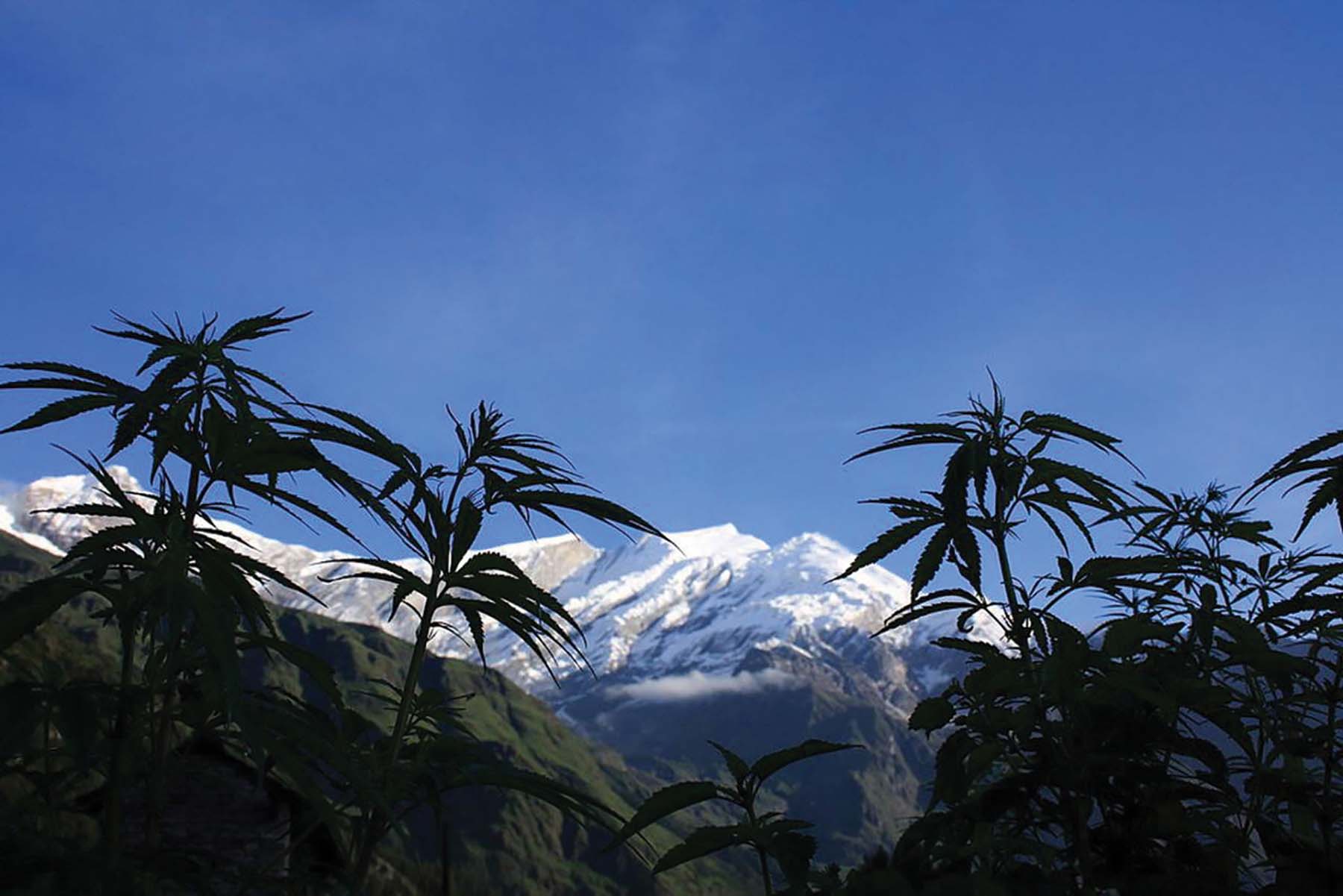
There was no warning the bees would eventually be in the middle of a Cannabis grow. However, on the day Oregon law changed to allow citizens to grow Cannabis, an odour some described as ‘heavenly’ and others referred to as ‘skunk-like’ emanated from the fields. When told the bees had access to Cannabis, people would ask whether the bees were ‘buzzed’ and whether their honey would make people ‘high’ (euphoric). This was a fascinating question! Would the bees (quite unintentionally) produce neuro-active honey? This began a line of inquiry by Sharon to determine whether bees are interested in Cannabis, what they might glean from it nutritionally and the effects of Cannabis on bees and bee products. Her observation of the bees revealed there was apparently no interaction in spite of the abundance of Cannabis plants in close proximity to the hives. Why not? One hypothesis was that the bees were not attracted to the aroma of Cannabis plants.
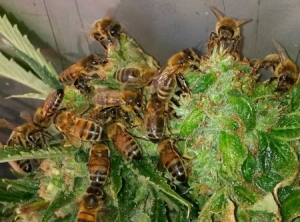 Bees have an exquisite olfactory sense that they use to detect pheromones of other bees and to find nectar. They are also attracted to colours and these two appeals to the senses are like neon billboards for finding food and mating opportunities. Cannabis does not have these attributes. It does not produce a smell that would attract bees, nor is it colourful and finally, and most importantly, it is unable to provide a reward in the form of floral nectar. As those familiar with Apis mellifera know, it is nectar and not pollen that is required by bees to make honey. There are other reasons bees would not find Cannabis attractive. However, an apparently contradictory piece of video footage turned up on social media in 2015. The video showed seemingly excited honey bees buzzing around and alighting upon a Cannabis plant from which they appeared to be feeding. Many viewers seeing that footage probably believe the bees derived some chemical excitement from their contact with the plant. However this is very unlikely because bees have no neuro-receptors that would allow them to apprehend the neuro-active elements present in Cannabis.
Bees have an exquisite olfactory sense that they use to detect pheromones of other bees and to find nectar. They are also attracted to colours and these two appeals to the senses are like neon billboards for finding food and mating opportunities. Cannabis does not have these attributes. It does not produce a smell that would attract bees, nor is it colourful and finally, and most importantly, it is unable to provide a reward in the form of floral nectar. As those familiar with Apis mellifera know, it is nectar and not pollen that is required by bees to make honey. There are other reasons bees would not find Cannabis attractive. However, an apparently contradictory piece of video footage turned up on social media in 2015. The video showed seemingly excited honey bees buzzing around and alighting upon a Cannabis plant from which they appeared to be feeding. Many viewers seeing that footage probably believe the bees derived some chemical excitement from their contact with the plant. However this is very unlikely because bees have no neuro-receptors that would allow them to apprehend the neuro-active elements present in Cannabis. 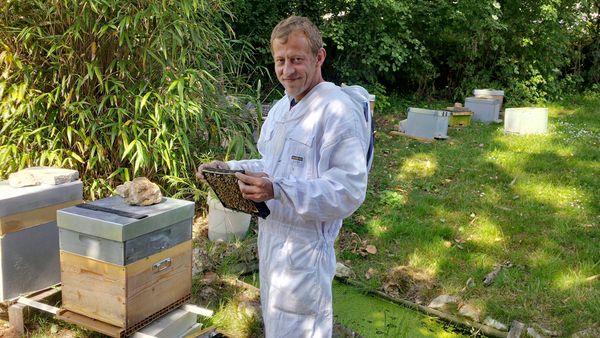
In a 2001 article, Cannabinoid receptors are absent in insects, the authors revealed insects do not produce arachidonic acid (polyunsaturated Omega 6 fatty acid) which is a precursor of necessary ligands (molecules that bind to other, usually larger molecules). It is thought that the cannabinoid (CB) receptor was lost in insects over the course of evolution. The authors also noted the CB receptor appears to be the only known neuro-receptor present in mammals and absent in insects. Because of its documented absence, bees are unable to experience Cannabis the same way humans do. Apparently the story circulating behind the bee video footage was that middle-aged French bee-keeper ‘Nicolas Trainerbees’ (a pseudonym), freely admitted to spraying ‘sugar water’ on female Cannabis flowers to entice the bees. He was trying to ‘train’ them to harvest the resin of the Cannabis plant to make propolis, a special gum which the bees use everywhere in the hive. As to his purported ‘Canna Honey’, the female Cannabis flowers produce tiny, resinous, crystal like structures called trichomes. These sticky structures help pollen to stick to the flower for pollination and within these trichomes are the cannabinoids.
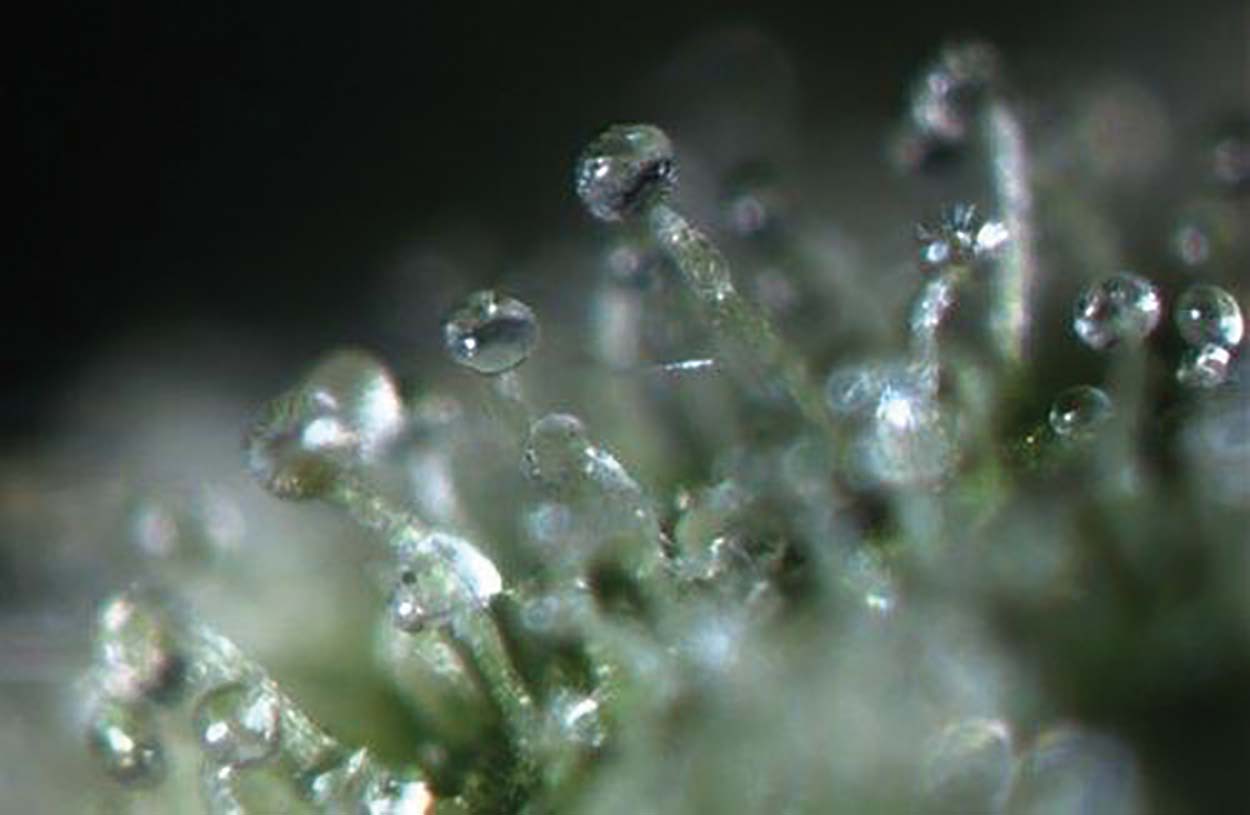
However, trichomes are oil-soluble, not water-soluble and honey is water-based. The next often asked question is whether honey made by bees having access to Cannabis plants contains THC and whether it exerts a neuro-active effect on those consuming it. The Cannabis plant is dioecious, meaning male and female flowers are produced by different individuals, male and female plants. The Cannabis plant is also anemophilious, wind pollinated (mostly), and therefore has not evolved to attract bees, except perhaps in extreme dearth situations. Male flowers, which produce pollen, do not contain any cannabinoids, however, so lack the active ingredients which are what give the desired ‘effects’. The existing scholarly article, Cannabis sativa – an important subsistence pollen source for apis mellifera, on the topic notes that Cannabis pollen seems to be a food of last resort for bees. The author notes that bees (in India) turned to Cannabis plants as a source of protein but only visited male plants during times of dehiscence (spontaneous bursting open) when the male plant’s reproductive organs released pollen and that bees were only interested in that pollen during a pollen dearth.

The Abstract of Cannabis sativa – an important subsistence pollen source for apis mellifera, states:
“Cannabis sativa is an important source of pollen for Apis mellifera during the period of floral scarcity (May and June) when major flora is absent. Foraging of bees on the herb under experiment took place during morning and evening hours, while during rest of the day activity remained totally ceased. All the foraging bees were pollen gatherers as the plant provides pollen only. Maximum foraging took place during morning, however pollen was also collected thoroughly by specific sweeping activity and scrabbling behaviour during evening hours. Foraging frequency of bees was more during morning as compared to that at evening. Average pollen load observed was 4 mg / bee. Abundance, Foraging behaviour and pollen loads indicated that this annual herb is a good source of pollen during dearth period in summer”.
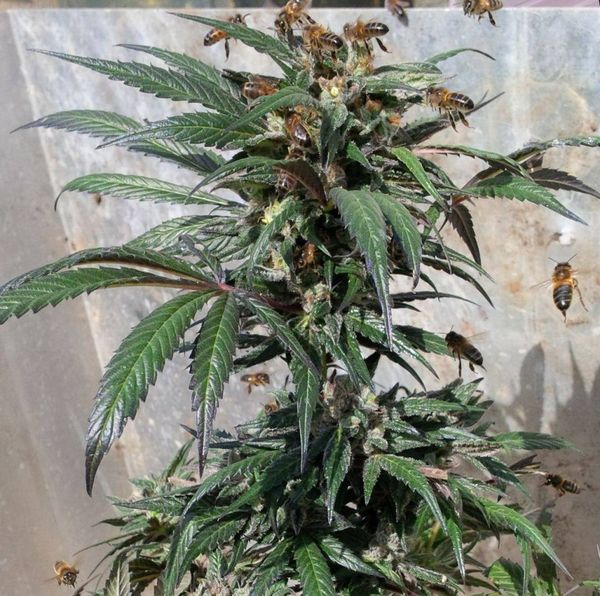 So how do we account for reports of persons who say they have seen bees congregating and apparently foraging on female plants or of images available on social media? Sharon approached Norman Carreck (Science and Senior Director of the Journal of the Apiculture Research) who suggested the possible source of the female plant’s attractiveness to bees could be ‘extra floral nectaries’ documented as an attribute of the Cannabis plant by John Free (1970) in his book, Insect Pollination of Crops. Extra floral nectaries include glands residing outside the calyx producing both water and sugars. There are no formal reports of extra floral nectaries in Cannabis plants other than the one referenced by Mr Free. However, if Cannabis plants are shown to have these, they could serve a defensive purpose by attracting ants which protect the plant from herbivores, or they might serve to attract bees. However, Cannabis is known to have glandular trichomes (plant hairs that secrete fluid), which could also be a plant feature interesting to bees suggested Dr Marjorie Weber, Postdoctoral Fellow, Centre for Population Biology, University of California Davis, in January 2016.
So how do we account for reports of persons who say they have seen bees congregating and apparently foraging on female plants or of images available on social media? Sharon approached Norman Carreck (Science and Senior Director of the Journal of the Apiculture Research) who suggested the possible source of the female plant’s attractiveness to bees could be ‘extra floral nectaries’ documented as an attribute of the Cannabis plant by John Free (1970) in his book, Insect Pollination of Crops. Extra floral nectaries include glands residing outside the calyx producing both water and sugars. There are no formal reports of extra floral nectaries in Cannabis plants other than the one referenced by Mr Free. However, if Cannabis plants are shown to have these, they could serve a defensive purpose by attracting ants which protect the plant from herbivores, or they might serve to attract bees. However, Cannabis is known to have glandular trichomes (plant hairs that secrete fluid), which could also be a plant feature interesting to bees suggested Dr Marjorie Weber, Postdoctoral Fellow, Centre for Population Biology, University of California Davis, in January 2016.
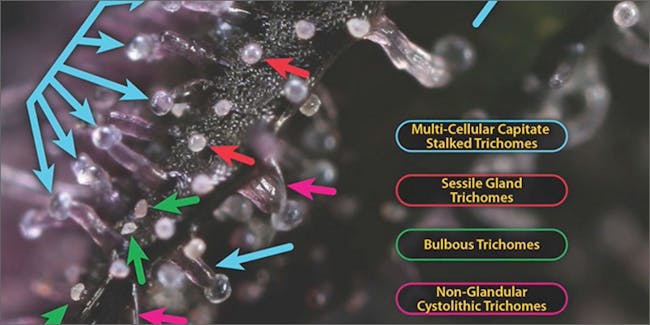
In Cannabis plants, bulbous type trichomes are the smallest at 15-30 microns and barely visible. Capitate-sessile trichomes measure from 25-100 microns across and capitate-stalked trichomes measure from 150-500 microns and are the most abundant. The latter contain the majority of the neuro-active cannabinoids (THC, THCV, CBN) and the effects of use are at least partly mediated by how much degradation is allowed prior to harvest. It appears that trichomes may have evolved for the purpose of making a plant less tasty to animals and insects, making the idea that bees are feeding from trichomes less plausible and more likely that they might be collecting resin from them. In a discussion with noted entomologist, Dr Dewey Caron, more ideas were advanced. First, that another naturally occurring source of interest for bees called ‘honeydew’ is often the object of their interest. Honeydew is simply the waste product of scale or other sucking insects which Cannabis is likely to host. These tiny insects probably concentrate their feeding (and excretion) at the tender surfaces of new plant growth and produce tasty waste products that bees might feed on.

Second is the possibility that bees might be collecting resins for purposes of making propolis (a sticky bee product used to sanitise, reinforce and weatherproof the hive) and third, that bees demonstrating activity on Cannabis plants might even be seeking moisture from irrigation, as suggested by Dr Caron. Presently, it seems that some aspects of the relationship between bees and Cannabis are not yet verified. Judging from statements occurring in public discourse, misinformation about bees, Cannabis and honey based upon legend and lore exists among some of the public. Much may yet be discovered, but some hypotheses are more likely true than others: First, it appears that bees cannot experience altered neuro-physiology as a result of exposure to Cannabis given they have no neuro-receptors for the chemical it contains. Second, the literature suggests they do not prefer Cannabis pollen but will resort to visiting male plants and collecting pollen from them mostly during a floral dearth. Third, if bees congregate and appear to be feeding upon female plants it is not to collect floral nectar because Cannabis does not produce flowers containing nectar; there is no known reason for the plant to produce nectar to attract pollinators due to the fact that it has evolved as a wind pollinated plant.

However the plant may produce water and sugars if extra floral nectaries are proved to be present, which could account for observations and anecdotes about bees congregating. Fourth, it is possible that an extra floral plant exudate might be used by bees to make honey and one can speculate about the presence of the precursors of neuro-active chemicals. It seems unlikely though unless the bees are actually foraging on trichomes. Trichomes have evolved to protect the plant from the predatory interests of animals and insects so the idea of bees foraging from them seems unlikely. The common use of the term ‘sugar’ to describe the frosty looking trichomes which have become opaque may further cloud the issue, bringing some to equate trichomes with sweetness. In fact, people who advocate juicing Cannabis reference the need to mix it with other vegetable juice to cut the bitter taste. Generally bees do not seem to seek out bitter fluids. Fifth, even if the resulting honey did contain such alkaloids, bee products would not be neuro-active without heat being applied for the purpose of converting alkaloids from an inactive to an active state (decarboxylation).
 Thus persons reporting euphoria after eating raw honey made by bees with access to Cannabis are much more likely to be reporting a psychological phenomenon rather than a physiological one. Bees also have an affinity for honeydew (waste products of scale and other insects that inhabit and forage in Cannabis plants) therefore any interest bees demonstrate toward this plant could be based on the presence of honeydew, or even due to bees’ interest in collecting moisture or resin. A final possibility is that bees might be ‘trained’ to collect whatever substances are available from the plant as a result of experiencing a conditioning paradigm. Under such circumstances they might learn to associate the plant odour with a reward (sugar water) which could account for the enthusiasm they appear to be showing in the above-referenced video. Future observation will likely yield more information about Cannabis and how bees interact with this plant. Not known is the composition of contents of the guts of bees appearing to forage on Cannabis or even the composition of their propolis. No micro observation of their interaction with the plant is readily available either. Given the expansion of legal Cannabis growing in some American states it seems likely there will be more interest and opportunity for systematic observation and research allowing anecdotal reports and scientific data to be accurately reconciled.
Thus persons reporting euphoria after eating raw honey made by bees with access to Cannabis are much more likely to be reporting a psychological phenomenon rather than a physiological one. Bees also have an affinity for honeydew (waste products of scale and other insects that inhabit and forage in Cannabis plants) therefore any interest bees demonstrate toward this plant could be based on the presence of honeydew, or even due to bees’ interest in collecting moisture or resin. A final possibility is that bees might be ‘trained’ to collect whatever substances are available from the plant as a result of experiencing a conditioning paradigm. Under such circumstances they might learn to associate the plant odour with a reward (sugar water) which could account for the enthusiasm they appear to be showing in the above-referenced video. Future observation will likely yield more information about Cannabis and how bees interact with this plant. Not known is the composition of contents of the guts of bees appearing to forage on Cannabis or even the composition of their propolis. No micro observation of their interaction with the plant is readily available either. Given the expansion of legal Cannabis growing in some American states it seems likely there will be more interest and opportunity for systematic observation and research allowing anecdotal reports and scientific data to be accurately reconciled.

Elizabeth Vernon, known as “Queen Bee” in her home state of New Jersey in the US, is an apiarist and certified massage therapist with a degree in Eastern Medicine. She combines her two passions, healing and beekeeping, by infusing botanicals like Cannabis into honey with her Magical Butter machine. Adding Cannabis to honey creates a powerful and healthy natural remedy, since both are known to have healing anti-bacterial and anti-inflammatory properties. Cannabis-infused honey can be used topically or ingested, depending on the desired effects. Infusing honey has been practiced for over 3,000 years. Honey is an extremely versatile base with a large number of healing properties. Adding different herbs and blends of herbs can create a powerful combination that can prevent and fight illness and disease. There are many different methods and the best practice with crafting anything is to find your own balance, do research and figure out what works best for you.

There are so many different variables to consider; Working with fresh ingredients or dry? Planning a cold infusion or warm infusion? What season is it? Honey is always best to work with when the temperature is warmer and using a Magical Butter machine (or similar) saves time and energy. As honey can’t bind to Cannabis, and honey can’t be made into Cannabis-infused honey by bees themselves, the best way is to make a tincture and to add it to the honey. But without any fat, the herb has nothing to bind to, so adding infused coconut oil with the tincture works amazingly well, as without binding the THC to a fat molecule in the likes of coconut oil, most of the effect will be lost. Coconut oil is a saturated fat, allowing maximum absorption of cannabinoids and is much more healthful for you than saturated animal fat; definitely the best option for vegans and those concerned about health. Tinctures are, without a doubt, the oldest mass-market way of extracting and consuming cannabinoids and terpenes found in the trichomes of the Cannabis plant. During the majority of the 19th century, physicians from North America, the United Kingdom and Europe dispensed, recommended and prescribed Cannabis tinctures for a wide variety of common ailments.

Adapted from Bees and Cannabis with The Benefits Of Cannabis-Infused Honey

